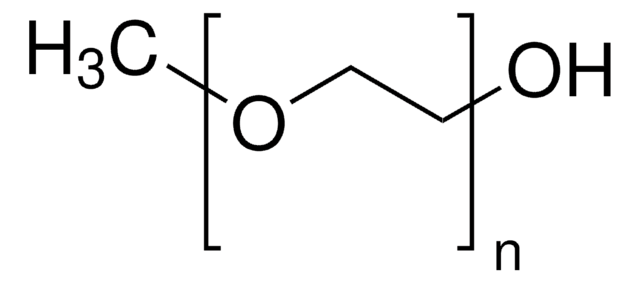推荐产品
product name
聚乙二醇甲基醚, average Mn 20,000
蒸汽密度
>1 (vs air)
蒸汽壓力
0.05 mmHg ( 20 °C)
形狀
powder or crystals
分子量
average Mn 20,000
mp
64-69 °C
Mw/Mn
≤1.2
Ω-end
hydroxyl
α-end
methoxy
儲存溫度
−20°C
InChI
1S/C3H8O2/c1-5-3-2-4/h4H,2-3H2,1H3
InChI 密鑰
XNWFRZJHXBZDAG-UHFFFAOYSA-N
正在寻找类似产品? 访问 产品对比指南
應用
- Deoxycholic acid-grafted PEGylated chitosan micelles for the delivery of mitomycin C.:开发脱氧胆酸接枝的PEG化壳聚糖胶束用于有效递送丝裂霉素C,说明PEG化物质在药物制剂和药物传输系统中的应用前景(Zhang et al., 2015)。
儲存類別代碼
11 - Combustible Solids
水污染物質分類(WGK)
WGK 1
閃點(°F)
359.6 °F
閃點(°C)
182 °C
其他客户在看
商品
Progress in biotechnology fields such as tissue engineering and drug delivery is accompanied by an increasing demand for diverse functional biomaterials. One class of biomaterials that has been the subject of intense research interest is hydrogels, because they closely mimic the natural environment of cells, both chemically and physically and therefore can be used as support to grow cells. This article specifically discusses poly(ethylene glycol) (PEG) hydrogels, which are good for biological applications because they do not generally elicit an immune response. PEGs offer a readily available, easy to modify polymer for widespread use in hydrogel fabrication, including 2D and 3D scaffold for tissue culture. The degradable linkages also enable a variety of applications for release of therapeutic agents.
Devising biomaterial scaffolds that are capable of recapitulating critical aspects of the complex extracellular nature of living tissues in a threedimensional (3D) fashion is a challenging requirement in the field of tissue engineering and regenerative medicine.
我们的科学家团队拥有各种研究领域经验,包括生命科学、材料科学、化学合成、色谱、分析及许多其他领域.
联系技术服务部门

